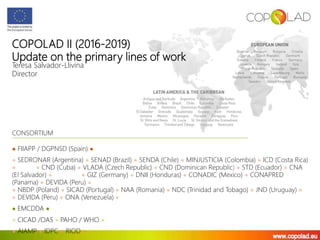This document provides an update on the primary lines of work of COPOLAD II, an international drug policy cooperation program between the EU and Latin American countries from 2016-2019. It outlines the program's general objectives to enhance evidence-based drug policies focusing on human rights and public health. The four main components are: 1) consolidating national drug observatories to monitor indicators, 2) building capacity in drug demand reduction, 3) building capacity in reducing drug supply, and 4) supporting the EU-CELAC coordination mechanism on drugs. Key challenges addressed include new psychoactive substances, precursor diversion, and increasing drug availability online.



































